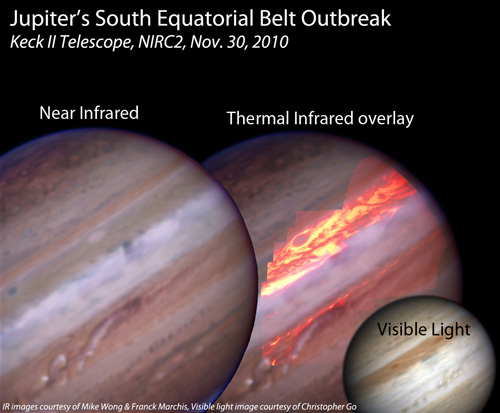What is the Temperature of Jupiter?
With an average temperature of minus 234 degrees Fahrenheit (minus 145 degrees Celsius), Jupiter is frigid even in its warmest weather. Unlike Earth, whose temperature varies as one moves closer to or farther from the equator, Jupiter's temperature depends more on height above the surface. This is because heat is driven not by the sun but by the interior of the planet.
Layers of gas
Jupiter is made up predominantly of hydrogen, with some helium. Small traces of other gases also contribute to the planet's composition. These gases fill the entire planet, descending all the way to the core. The surface, as identified by scientists, is the region where the pressure is equal to that at the surface of Earth, one bar. But don't be misled by the term; you can't stand on Jupiter's surface, because it isn't solid. Below the surface, the gas becomes liquid and even plasma, all the way to the central core.
Within the regions of gas, the temperature varies in the layers of Jupiter's atmosphere. From the surface to about 30 miles (50 kilometers) up, the temperature decreases as you ascend, ranging from minus 100 C (minus 150 F) to minus 160 C (minus 260 F). In the next layer, the temperature increases with altitude, returning to up to minus 150 F again. At the top of the atmosphere, temperatures can reach as high as 1,340 F (725 C), over 600 miles (1,000 kilometers) above the planet's surface.
Heating sources
Because Jupiter's distance from the sun is an average of 484 million miles (778 million km), heat from the star is weak, though it does contribute. Much of the heating of the gases come from the inside of planet itself. Beneath the surface, convection from the liquid and plasma hydrogen generate more heat than from the sun. This convection keeps the massive gas giant warm enough to avoid it freezing into an icy world.
— Nola Taylor Redd, SPACE.com Contributor
Breaking space news, the latest updates on rocket launches, skywatching events and more!
Related:

Nola Taylor Tillman is a contributing writer for Space.com. She loves all things space and astronomy-related, and always wants to learn more. She has a Bachelor's degree in English and Astrophysics from Agnes Scott College and served as an intern at Sky & Telescope magazine. She loves to speak to groups on astronomy-related subjects. She lives with her husband in Atlanta, Georgia. Follow her on Bluesky at @astrowriter.social.bluesky

